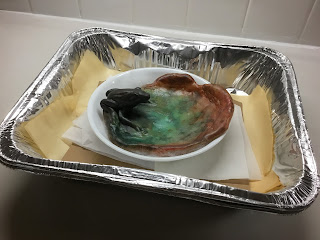Translucent Lace Tutorial
This vase was decorated with a new technique ( for me), I wanted to create a realistic shimmering lace to change the profile of the vase.. Below is what the vase looked like before decorating with PC.
When I started to add the flowers, the vase just didn't look right so I decided to try and add translucent lace, if possible, to soften the whole effect. Here are pictures of the steps I used to make the lace.
.
This lace dollie was rolled into a sheet of Premo Accents white Translucent clay. The clay was conditioned on the pasta machine at a 4 or 5 setting. It's important to keep the clay as thin as possible to make it more translucent and ethereal after curing. but if the clay is too thin, it will sag and break at the cut out areas,
Using a straw, or a small punch, "cut" the holes in the lace. (Try not to get them too close together because they will most likely break when gravity pulls the clay down. (Several of my holes broke so I know this from experience) :)
I used gold mica powder to add the metallic shimmer to the lace and then I cut it out with a craft knife.
It was ready to drape onto the vase in a pleasing way, if possible. The pictures below show how I arranged it.
Ready to go into the oven. I used Polyester fiber fill to "plump" out the lace before baking. Gravity still pulled it down so I cured it face up laying on a bed of fiber fill. The lace was a little wonky on the left side when I took it out of the oven, so I reattached it with the help of super glue.
I place my clay in a cold oven then set it for 275 degrees.
It bakes for 1 hour and 20 minutes.
I think this technique has a lot of potential to add soft flowing lines to our creations. If you try to make some of this beautiful lace. please share your creation with me, I can learn from your experience also. Please contact me on Facebook or leave a comment here in blogger.
Facebook user name, "Evie Campbell"























































